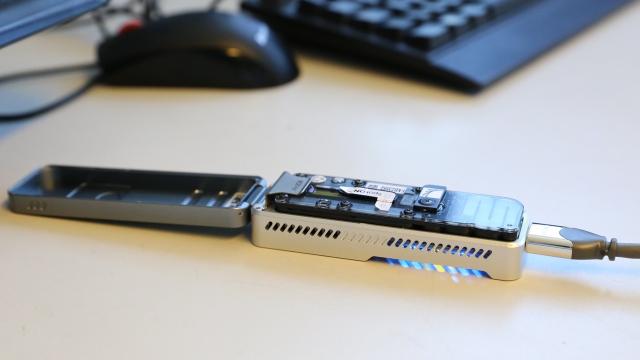Scientists reported this week that they have sequenced and assembled the human genome using a pocket-sized sequencer for the first time.
Image: Matt Loose/University of Nottingham
The researchers accomplished their feat using the MinION nanopore sequencer, reading almost a hundred billion base pairs of data and analysing huge chunks of DNA. The product is targeted towards scientists, mainly, but costs as little as a thousand dollars. Other DNA-sequencing machines are about the size of a standard office photocopier.
Sequencing the human genome has become a benchmark for determining how well DNA sequencers work, the authors write in the paper published in Nature Biotechnology. Unlike other methods, which read chunks of DNA perhaps a hundred or so base pairs in length, the MinION can read sequences as long as 882,000 base pairs in length using the nanopore technology. As a reminder from high school biology, the base pairs are the As, Ts, Cs and Gs that make up our genetic code.
“There’s a lot of things that are exciting about this,” study author Matthew Loose from the University of Nottingham told Gizmodo. “We can sequence much larger chunks of DNA than we’ve ever seen before.” Loose, as well as several other authors on the paper, receive funding in some way from MinION’s parent company, Oxford Nanopore Technologies.
The nanopore technique begins with a voltage passed across a tiny pore in a membrane. The device runs DNA through the voltage, which changes the signals, and converts the tiny changes into the base pairs, and then into the data analysed by a computer.
As of now, MinION’s error rate (detecting the wrong letter) is fairly high, or at least higher than other methods – a few in a hundred. That gets better with repeating the analysis over the same sequence, but after processing a lot of DNA, there are still errors on the order of one in a thousand. Loose said they’re working on learning more about those errors, and whether they’re issues with sensitivity or if the machine is misreading actual physical modifications in the molecules themselves.
Also, doing this sequence took a ton of processing time‚ around 50,000 CPU hours, said Loose. Ars Technica reports that with the long files, “some analysis software couldn’t work with the nanopore reads at all.”
But the time probably paid off – the machine managed to fill in 12 pieces of the human genome, reports STAT. Around four per cent to eight per cent of the human genome remains to be sequenced.
Soon, the another device from the company, SmidgION, should be able to sequence directly onto a mobile phone, in case you need to need to know what kind of yeast is growing on your banana on-the-go.
Really, this just shows how quickly DNA sequencing technology has advanced. Loose said: “We’re getting to crazy levels of DNA detection and portability.”
